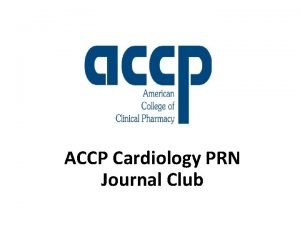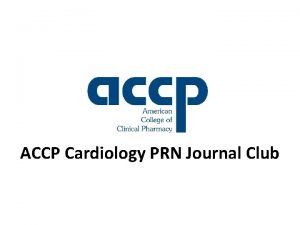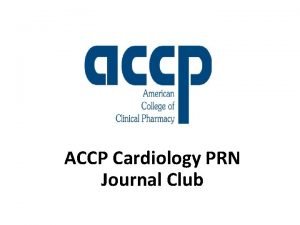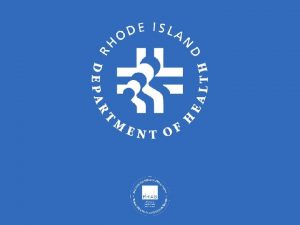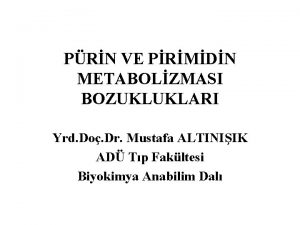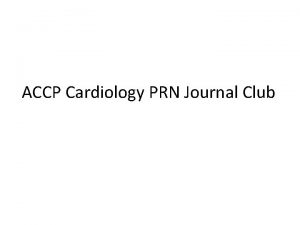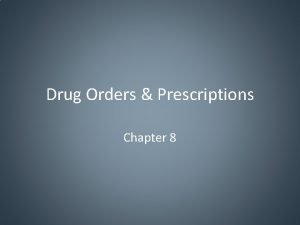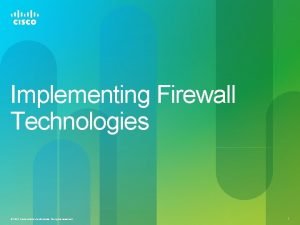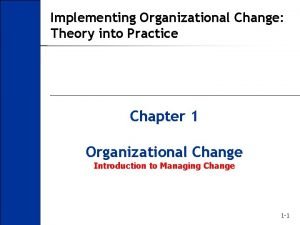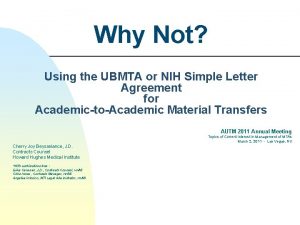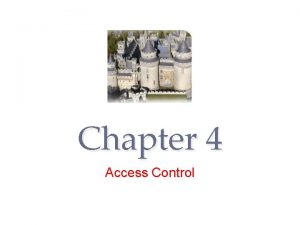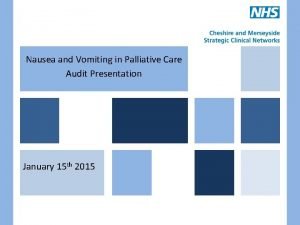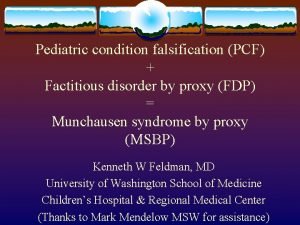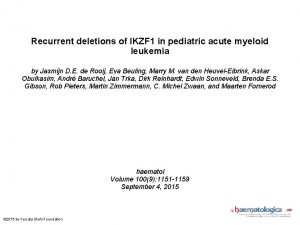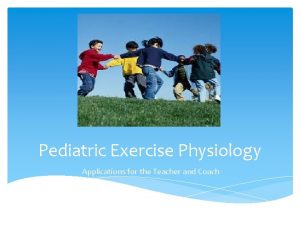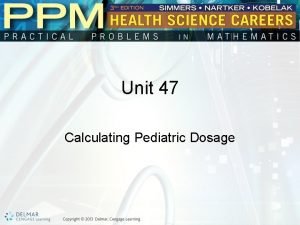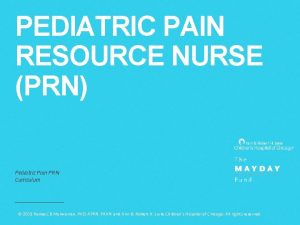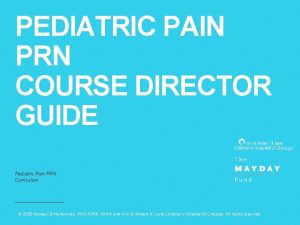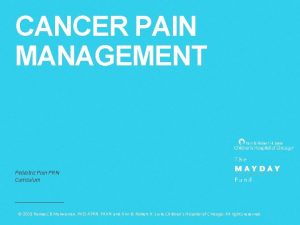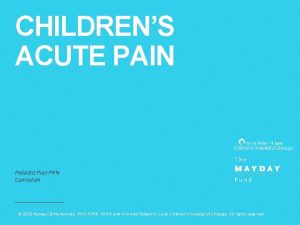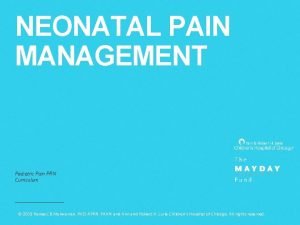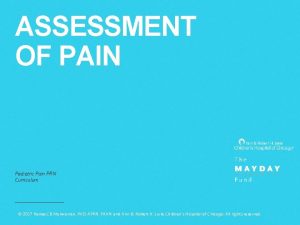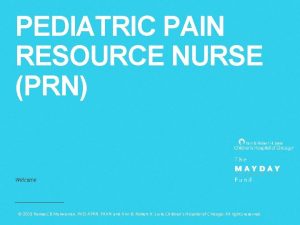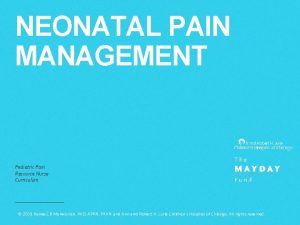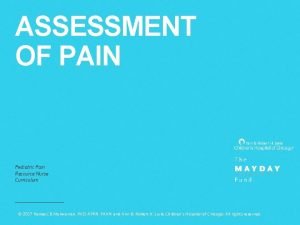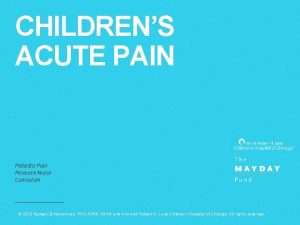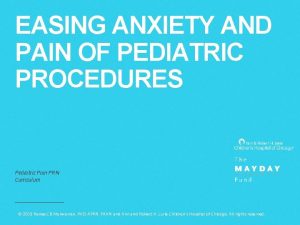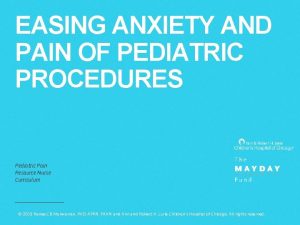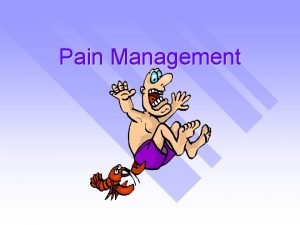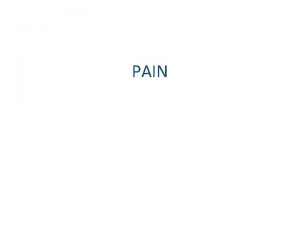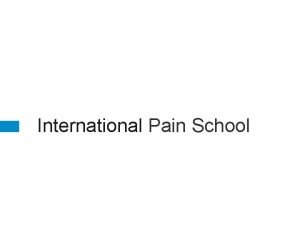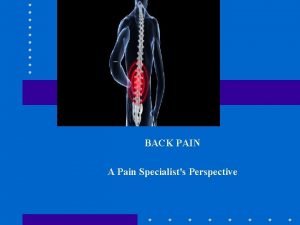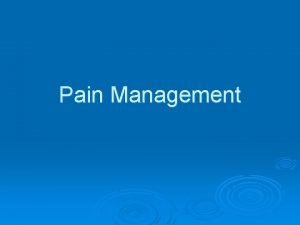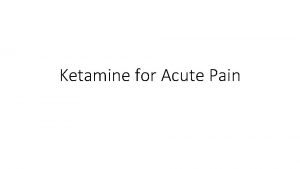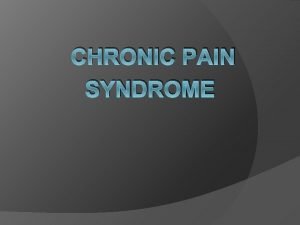IMPLEMENTING THE PRN ROLE Pediatric Pain PRN Curriculum
























































































- Slides: 88

IMPLEMENTING THE PRN ROLE Pediatric Pain PRN Curriculum © 2019 Renee CB Manworren, Ph. D, APRN, FAAN and Ann & Robert H. Lurie Children’s Hospital of Chicago. All rights reserved.

Table of Contents Objectives • Engage patients, families, leaders, and the interdisciplinary healthcare teams to identify opportunities and develop an action plan to improve sensitivity to children’s pain and clinical care provided. • Assess your unit, specialty, organization, and community for opportunities to successfully educate patients/families and/or the interdisciplinary health care team, conduct evidence-based practice, research, and/or quality improvement projects that will facilitate optimal pain management and systemize optimal pain care. • Analyze your potential for success in the PRN role based on your qualifications and your evaluation of your institution’s leadership commitment, interdisciplinary teamwork, and resources to address staff/organization related challenges and barriers to optimal pain care. • Evaluate how your goals for the PRN role align with the outlined PRN responsibilities and the institutions care priorities. page page 3 11 20 24 33 What is a Pain Resource Nurse? PRN Responsibilities Clinical Standards Implementing the PRN Role Identify Opportunities page page 39 58 64 75 79 Your Role as a Change Agent Leveraging Informatics Advocating for Patients and Families In Summary Appendix | 2

What is a Pain Resource Nurse?

Take a minute to reflect… Type your answer here. • Is your leadership committed to your active involvement in this effort? Are you? • Who are key members of your collaborative interdisciplinary team who effectively communicate vertically and horizontally? • Where can you focus your first effort for the quickest win and biggest reward? • Do you have the resources you need to secure success? | 4

The Pain Resource Nurse (PRN) Role A Pain Resource Nurse (PRN) is a registered nurse who interfaces with healthcare team members, patients, and families as a resource, change agent, and leader to disseminate information, facilitate optimal pain management, and systemize quality pain care. A systematic review of PRN programs identified four key elements for a successful program: 1) Committed leadership and active PRN involvement to embed a culture of effective pain management throughout an organization. 2) Collaborative interdisciplinary teamwork and communication. PRNs influence care at the unit, specialty, organization, and community level 3) Focused effort to address staff-related and organization-related challenges and barriers to pain management. 4) Uses a combination of strategies and resources to overcome barriers to optimal pain management. | 5

PRN Qualifications may vary by institutional commitment, culture, structure, and employee policies • Confident professional Registered Nurse, bachelors’ degree preferred • Defined clinical experience and demonstrated competence as a nurse and leader on current unit, clinical practice or specialty • Able to articulate beliefs, knowledge, and attitudes about pain in a complex healthcare system • Demonstrates knowledge and expertise in providing nursing care, problem solving, critical thinking, and implementing standards • Demonstrates effective interpersonal skills, and flexible thinking. Able to collaborate with the interdisciplinary team • Open to diverse strategies for pain care and pain care improvement • Expresses interest and a commitment to providing the best pain management available • Shares knowledge with staff through role modeling and teaching • Demonstrates effective written and verbal communication skills • Able to prioritize and independently manage time | 6

Characteristics of a Successful PRN Personal Characteristics: Clinical Leadership Skills: Nursing Virtuosity is the performance of the professional discipline with great knowledge, skill, and intuitiveness by an expert in caring. • Committed • Advocate • Confident • Coach • Contagious enthusiasm • Collaborator The PRN demonstrates technical proficiency, sustainable talent, innovation, and connectiveness in care. The PRN reacts to the subtleties of patients’ conditions and the dynamics of interpersonal relations based on knowledge and experience, modulated by workload, and evaluated by the patient, family, leadership, and interdisciplinary health team. • Flexible • Change Champion • Open-minded • Provides effective feedback • Passionate • Risk manager • Patient • Role Model • Professionally Credible • Skilled in Conflict resolution • Resilient • Teambuilder • Yours? • Others? (Manworren, 2010). | 7

Measures of Successful PRN Program Outcomes Strategies for successful implementation of the PRN role: • • • Identify opportunities to improve pain care and promote an organizational culture of sensitivity to children’s pain Align work with organizational priorities Promote PRN role; make it visible and accessible Document and communicate PRN activities and outcomes § Increased documentation of pain assessments and interventions § Greater awareness of the problem of undertreated pain; improved knowledge and attitudes § Implementation of multimodal pain treatment protocols, including pharmacologic and biobehavioral (non-pharmacologic) strategies § Improved pain relief § Improved patient knowledge and satisfaction with pain care § Enhanced nurse empowerment, job satisfaction, and retention Seek feedback from patients, families, nurses, healthcare team members, leadership Benefits • Specialized ongoing continuing education • Leadership and career development opportunities • Recognition of clinical expertise and leadership role • Support for identified educational, evidence-based practice, performance improvement, and/or research projects related to pain management • Opportunities to present and publish project findings internally and externally in local, regional, national and international forums Challenges • Time, resources, role conflict and ambiguity | 8

Take a minute to reflect… Type your answers here. • What are your organizational priorities? • How will you successfully brand the PRN role? • Who can help you overcome these challenges? • Who can help you access the resources you need? | 9

Leadership Commitment to PRN and PRN Role Management is doing things right; leadership is doing the right things. ~ Peter Drucker Leadership should commit to provide: • Time for initial training and ongoing continuing education • Commitment to a culture of effective pain management throughout an organization • Program facilitation by a leader with expertise in pain management and education • Ongoing role development • Communication and provide support for PRN role and project • Help with way finding, identification of resources, and effective methods of addressing staff and organizational challenges and barriers. • Facilitate interdisciplinary communication, cooperation, and teamwork to advance PRN role • Collaboration with PRN to evaluate role • Evaluation of effectiveness of PRN | 10

PRN Responsibilities

What PRNs Do Personal Professional Development Care Provider Educator Responsibilities vary by institutional commitment, culture, structure, needs, opportunities, and expectations Scientist Change Agent Leader | 12

Responsibilities Personal Professional Development • • • Assess personal knowledge and attitudes about pain and pain care • Regular active attendance at PRN meetings and other committee meetings as defined Negotiate with leadership for time to complete the responsibilities of the PRN role • Care Provider Educator Act as a role model for others in the care of patients by performing thorough pain assessments, providing pharmacologic and biobehavioral interventions, evaluating outcomes, teaching patients and families about pain care, and communicating pain care through documentation and verbally during patient care rounds and reports Advocates for patients experiencing pain as a resource for staff and by escalating concerns to healthcare team members, leadership, and committees • • Educates patients and families in pain care through developmentally appropriate strategies Improves health literacy related to children’s pain through consistent use of words with discrete and powerful meaning Disseminates information about pain care and clinical practice guidelines to the interdisciplinary healthcare team through a variety of creative strategies Coordinates unit education related to pain | 13

Responsibilities Change Agent • • Performs informal needs assessment of clinical unit, specialty, or clinic practice setting including a review of staff knowledge and attitudes about pain, general pain management practices, and documentation to target areas for improvement Supports institution-wide efforts to improve pain care Facilitates ongoing quality improvement projects related to pain Leads projects to facilitate optimal pain management and systemize quality pain care Scientist Leader • • • Identifies gaps in evidencebased guidance for pediatric pain care Explores opportunities to pursue new knowledge and innovation • Provides feedback to healthcare team members regarding pain management practices Recognizes and addresses ethical issues related to pain care | 14

PRN Projects: Patient/Family Educator PRNs should lead projects that facilitate optimal pain management and systemize quality pain care Projects of importance should be developed based on needs assessment and reflect the PRNs strengths and interests. Projects should be outcome focused and time limited. Examples of recommended project responsibilities. Health Literacy and/or Patient/Family Education • • Identifies patient/family education needs • • Collaborates to develop and implement an action plan Author: * PRN Project Leadership Potential projects • • • Health Literacy and/or Patient/Family Education Nursing or Interdisciplinary Healthcare Team Education • • Assembles a team or joins or consults with a developed team to address identified education need Assists in the development and dissemination of education materials for patients and families Acts as a resource for patient/family education related to pain care. Collaborates with the leadership, Educators and other resources to evaluate progress Evidence-based Practice Quality Improvement Research * Author: Videoplasty. com Books with Apple Flat Icon Vector. svg from Wikimedia Commons | License: Creative Commons Attribution-Share. Alike 4. 0 15

PRN Projects: Staff Educator More examples of recommended project responsibilities and potential projects: Nursing or Interdisciplinary Healthcare Team Education Role • • Identifies interdisciplinary teams’ education needs • • • Collaborates to develop and implement an action plan Assembles a team or joins or consults with a developed team to address identified education need Assists in the development and dissemination of education materials Employs effective education strategies, for example § Conducts pain rounds § Provides journal articles relevant to pain care provided on unit or clinical area § Coordinates in-services related to pain PRN Project Leadership Potential projects • • • Health Literacy and/or Patient/Family Education Nursing or Interdisciplinary Healthcare Team Education Evidence-based Practice Quality Improvement Research • • § Promotes pain-related educational opportunities Acts as a resource for healthcare provider and student education related to pain care. Collaborates with the leadership, educators, and other resources to evaluate progress toward advancing healthcare team knowledge and attitudes related to pain and pain care Potential Staff Education Projects https: //creativecommons. org/licen • • • Conducts an accreditation readiness campaign for Child. Kind or sa/4. 0/deed. de# The Joint Commission survey Assists in the coordination of Pain Awareness month activities & other pain education opportunities Attends national scientific conferences related to pain and shares newly gained knowledge | 16

PRN Projects More examples: Evidence-Based Practice Projects • • Develops an algorithm for evidence-based prevention of IV insertion pain Selects and implements use of an opioid risk assessment tool Designs a system to ensure equipment needed to provide developmentally appropriate biobehavioral treatments is available around the clock Develops and implements an evidence-based order set to treat the most common reason for pain on a clinical unit Quality Improvement Project Responsibilities PRN Project Leadership Potential projects • • • Health Literacy and/or Patient/Family Education Nursing or Interdisciplinary Healthcare Team Education Evidence-based Practice Quality Improvement Research • Plan • Do • Check • Act Research Projects • • Conducts a comparative effectiveness trial of PCA and PCA with continuous infusion Develops a pain assessment tool for patients with spina bifida Conducts a focus group with physical therapists to describe how they interact with nurses to manage children's pain before and during therapy Retrospectively reviews EHR to compare outcomes of two treatment protocols | 17

PRN networks PRNs need to network to stay current! • • Seek a mentor for PRN role. Network internally and externally (locally, nationally, and internationally). Societies • American Pain Society, especially the Pediatric Special Interest Group and Nursing Issues Special Interest Group americanpainsociety. org • • Regional Pain Societies American Society for Pain Management Nursing www. aspmn. org International Association for the Study of Pain (IASP), especially the Pediatric Special Interest Group https: //www. iasp-pain. org Society of Pediatric Nurses www. pedsnurses. org National Association of Pediatric Nurse Practitioners (NAPNAP) https: //www. napnap. org Association of Pediatric Hematology/Oncology Nurses (APHON) aphon. org Others? | 18

Take a minute to reflect… Type your answer here. • What are some potential projects you could take on in your PRN role? • Which PRN characteristic do you need to develop to carry out the project responsibilities suggested? • How can you better develop your personal and professional PRN networks? | 19

Clinical Standards

Accreditation Standards The Joint Commission accredits healthcare organizations by their Standards Related to Pain Assessment and Management. Conduct a gap analysis and recommendations to meet these standards. Leadership (LD) Standard LD. 04. 03. 13 Pain assessment and pain management, including safe opioid prescribing, is identified as an organizational priority for the hospital. APPLICABLE TO HOSPITALS Effective January 1, 2018 Medical Staff (MS) Standard MS. 03. 01. 03 The management and coordination of each patient’s care, treatment, and services is the responsibility of a practitioner with appropriate privileges. Standard MS. 05. 01 The organized medical staff has a leadership role in organization performance improvement activities to improve quality of care, treatment, and services and patient safety. Provision of Care, Treatment, and Services (PC) Standard PC. 01. 02. 07 The hospital assesses and manages the patient’s pain and minimizes the risks associated with treatment. Performance Improvement (PI) Standard PI. 01. 01 The hospital collects data to monitor its performance. . Standard PI 02. 01 The hospital compiles and analyzes data. | 21 See the Appendix for the draft language that goes live January 2018.

Child. Kind Principles Child. Kind is a global initiative aimed at reducing pain and unnecessary suffering in children by offering a special designation to those facilities that have demonstrated an institutional commitment to pain relief and by providing the technical support to achieve that goal. 5 Key Principles: 1. Presence of a facility-wide written policy on pain prevention, assessment, and management endorsed by hospital administration 2. Comprehensive and on-going education for staff, patients, and caregivers 3. Documentation that pain is assessed using a developmentally appropriate process 4. Creation of and access to specific evidence-informed protocols for pain management including pharmacologic, psychologic, and physical methods 5. Use of a regular institutional self-monitoring quality program | 22

Ethical Principles Definitions Beneficence Taking positive action to help others and the desire to do good; it is a core principle of patient advocacy Nonmaleficence The duty to do no harm Autonomy The rights of self-determination Justice The fair treatment of individuals and equitable allocation of healthcare resources. | 23

Implementing the PRN Role

How to Begin Establish an interdisciplinary team to explore opportunities for improvement, identify barriers, develop an action plan, champion change, and monitor outcomes. Prepare yourself • • Seek knowledge. • • Establish Interdisciplinary team. • Survey present practice in selected areas – compare to benchmarks. Identify impediments to change. Get buy-in from appropriate stakeholders empowered to make change. Develop and implement strategic action plan. Include active education, intuitive system changes, care audits, structured reinforcement, and timely feedback. Make efforts and outcomes visible- promote and reward change. Form a team • • • Identify qualified individual and invite them to participate. Select team leader/project leader. Set meeting times and location. Keep key stakeholders outside team informed. Decide on the focus and boundaries of the project. | 25

Engage Healthcare Professionals in Change PRNs engage the interdisciplinary healthcare team to improve pain care Rapid advances in care, changes in healthcare financing, and competing priorities make change in complex organizations, like hospitals , challenging. Clinical practice changes require a synthesized approach by interdisciplinary teams. The pain resource nurse is an ideal candidate to lead these team efforts. Three keys to engaging other healthcare professionals in change projects 1. Identify team members as early as possible while developing the change project 2. Pitch the project 3. Brand the project, but communicate in person Identify team members Pitch the project Brand the project | 26

Steps for Engaging Healthcare Professionals 1. Identify team members as early as possible while developing the change project • • Identify team members Choose team members you respect and know you can work with to achieve outcomes. Choose team members with both positional and informal leadership roles who can successfully champion changes in practice to improve pain management both in their profession and among the interprofessional healthcare team. Include no more than 20% nay-sayers 2. Pitch the Project • • Pitch the project Brand the project Team members need to feel and believe in the urgency of making the change. No matter how good you think the idea is, you have to convince them that there is an urgent reason to incorporate “one more change” in their already challenging world. • Go where there is buy-in and likelihood of success to create an internal success story. Ignore the “nay-sayers” until you have 80% buy-in. Then, engage them to identify the most difficult barriers. Frame the project as much as personally and as positively as you can. Highlight ways the project will personally benefit the organization and/or team members. “This will help you be more successful (or produce better outcomes)” Instead of: “You have to do this because it’s required (or policy). ” Use success stories of other units or divisions or peer organizations (other top tier Pediatric hospitals) BUT, let the change/process be customized for your culture. Let them get their fingerprints on it and make it personal. A “B+” approach with buy-in will always be better than your pure “best practice” or “A+” approach that is rejected. | 27

Steps for Engaging Healthcare Professionals 3. Brand the Project, but communicate to the person • • • Clear, compelling, accurate – and short Use “people-speak, ” not “brand-speak” Sometimes 5 words are better than 1 Think 1, 2, 3, - never 8, 9, or 10. Show, don’t tell Engage and challenge with questions Identify team members Pitch the project Brand the project | 28

Communicate, Communicate! Talk to team members in-person or at least, phone conversations. Both are far more effective than email. Be flexible and prepared to let go of your agenda. If the PRN is not sensitive to the work demands and pressures of other members of the healthcare team, the likelihood of success is greatly diminished. If you need to use written material, it should be as concise and to the point as possible. • • Bottom line on top. More detail is seldom better; less is more. Make an emotional connection • • • Explain facts Explain successes Be Concise Persuade Repeat memorable phrases Share your optimism and resolve! Keep team members informed and seek feedback to ensure communication has been successful. Tell your story Send a message for healthcare improvement: • Make it memorable • Make it resonate • Make it inspire action Check to see if the message was heard: • Problem • Solution • Ask • Urgency • Hope | 29

Build Trust and Rapport Build trust and rapport if you want others to follow your lead. It is essential to successfully getting buy-in. Once you have established trust, the speed in which you can make change takes a quantum leap. Trust is developed through: Credibility • • Respect Trust Fairness Deliver on promises and never promise something you can’t deliver Respect • • Value people as a whole person and treat everyone with respect • Be humble; no one trusts someone who seems to think they are the smartest person in the room and that their needs always take precedence of the needs of others. Convey that you understand their world and want to help them succeed Fairness • Communication Be dependable; always keep your commitments Avoid anything that could be perceived as a different or “special relationship” with another team member Communication • • Abundant, open, communication, preferably in person as much as possible Be a great listener | 30

Listen for Meaning Great Listening is the key to getting people to open up to your perspective. It is the foundation of effective communication, positive relationships and building trust. Being a great listener is simple…but doing it is hard. It means overcoming the greatest barrier to effective listening: Resisting the urge to “rush in and fix things” or “express your view. ” Doing this is particularly hard for smart, high performing, and successful people. Most of us listen passively; we are not “present” and are thinking of other things: • Great listeners confirm understanding with someone before speaking. “Seek first to understand, then to Be understood. ” ~Stephen Covey, 7 Habits of Highly Effective People Great listeners speak less than half the time “We have two ears and one mouth so that we can listen twice as much as we speak. ” ~Epictetus • What we are going to say next, formulating our “brilliant” next statement. Our next meeting, a deadline, errands we have to run after work, or what’s on our Phone. Really great listeners are focused exclusively on the person we are interacting with: • • The words they are saying Their nonverbal cues The feeling behind the message Understanding the other person’s point of view and the assumptions they are making. Great listeners respond on any commitments and follow-up agreed to in the discussion. | 31

Who’s on the team? Type your response here. 1. List key team members for developing your role as a PRN and for the success of your project. 2. List naysayers you think would work with you on the project to identify barriers (list only 1 for every 5 key team members). | 32

Identify Opportunities

Identify Opportunities Evidence • PICOT question Question • Search for evidence • Critically appraise evidence Use this model to identify opportunities to optimize patient care and advance clinical pain management • Engage interdisciplinary team • Develop action plan to integrate change into practice Teamwork Pilot • Obtain pre-data • Pilot practice change • Evaluate outcomes • Disseminate change internally • Disseminate change externally, if appropriate Disseminate | 34

Question • PICOT question Question Use a PICOT question format to define keywords and concepts Example: • In pediatric oncology patients who can provide self-report (P), how does use of nitrous oxide (I) compare to use of topical anesthetics (C) for preventing (T) the needle pain with port access(O)? Key PICOT Concepts Population Pediatric oncology patients Intervention Nitrous oxide Comparison Topical anesthetics Outcome Pain with port access * Time (T) May not be appropriate for all PICOT questions | 35

Evidence After identifying a PICOT question, review the literature to identify the best evidence before implementing a practice change. Evidence • Search for evidence • Critically appraise evidence 1. Search the literature for relevant related research • Critique of evidence-based practice guidelines. • Critique of systematic reviews. • Critique of primary research articles. • Contact experts (if needed) for information. 2. Synthesize the literature 3. Write summary recommendations/ evidence-based practice guideline Consult a medical librarian Librarians are experts in searching and obtaining literature. Search relevant databases and professional subscription resources Each database covers a different focus and can contain literature from different date ranges and different publications. Search more than one database Google Scholar can be a helpful tool, but remember that it is not peer-reviewed or human curated. Database Focus Nursing &allied CINAHL health After identifying a PICOT question, review the literature to identify the best evidence before Database of Cochrane implementing a practice change. Library Systematic Reviews ERIC Education Ovid MEDLINE Biomedical/ multi -specialty Psyc. INFO Psychology Pub. Med MEDLINE Biomedical/ multi -specialty | 36 See the Appendix for more information .

Decision point: is there enough evidence? What’s your next step? Type your answer here. • Discuss strength of evidence. • Contact additional experts as necessary. • Use other sources of evidence as necessary. • Decide if more research is necessary and feasible. • If you have enough evidence to proceed, draft/revise policy, procedure, standards. | 37

Teamwork • Engage interdisciplinary team • Develop action plan to integrate change into practice Teamwork The previous section on Implementing the PRN Role provides you with a good foundation for how to engage the interdisciplinary team. The next section on Your Role as a Change Agent explores how to develop your action plan and integrate change. Pilot 1. Select and collect outcome and/or process indicator data. Pilot 2. Implement changes in one unit/small number of patients PILOT • Opinion leader • Change champion • Obtain pre-date • Pilot practice change • Evaluate outcomes • Educate staff • Revise systems (documentation forms) to support practice change • Develop practice prompts Disseminate • Disseminate change internally • Disseminate change externally, if appropriate Disseminate • Decide on length of “trial” before collecting post implementation data 3. Collect and analyze outcome and process data Disseminate This step is about spreading the news. The next section on Your Role as a Change Agent gets into the details about how to do this. | 38

Your Role as a Change Agent

Some factors can be leveraged to increase the rate of diffusion Your job as a pediatric PRN is to be an innovator or early adopter of new pain management practices. • Relative advantage • Compatibility • Observability • Trialability • Complexity Multiple factors determine the rate of adoption You can begin to see where you might impact the rate of change and the sustainability of the innovation over time. Here’s an example of an innovation decision related to pain assessment: the timeline of pain assessment was done at judgement of nurse, and then recommendations for pain scales came out in papers. Then The Joint Commission made it a mandate… • Optional • Collective • Authority • Mass media • Interpersonal Attributes of the Innovation Communication Channels Types of Innovation Decision Nature of the Social Systems • Norms • Interconnectedness • Consequences And of course, TIME can be a serious factor affecting adoption of any change project. | 40

Phased Implementation I. Creating Awareness & Interest A phased implementation plan uses diffusion theory to achieve sustainability. Using Roger’s phases for diffusion of innovations, Cullen and Adams identified four phases of implementation. II. Building Knowledge & Commitment III. Promoting Action & Adoption IV. Pursuing Integration & Sustained Use The phases progress from passive to active and interactive. I. Creating Awareness & Interest Getting the attention of busy clinicians II. Building Knowledge & Commitment Preparing the clinical team forthcoming change III. Promoting Action & Adoption Implementing the change; go-live; requiring a behavior change IV. Pursuing Integration & Sustained Use Pursuing integration and sustaining use of the evidence-based practice which is to hardwire process into routine workflow Cullen, L. & Adams, S. (2012). Planning for Implementation of Evidence-Based Practice. Journal of Nursing Administration, 42(4), 222 -230 | 41

Phase I. Create Awareness & Interest I. Creating Awareness & Interest This stage is about getting attention. Highlight the advantage – strong evidence; likely to be helpful across all phases; can easily be shared within project purpose in reminders, unit posters, etc. Highlight compatibility – strong evidence; helpful to link the evidencebased practice change with existing unit values (reducing patient risk of infection). Create sound bites Draft three brief and easy-to-remember pieces of information about the evidence-based practice. Include one statement of each: • Why it is important? , • How it relates to our patients? , and • What actions they need to do (essential!)? . Goals What are the positives about the evidence-based practice? Think of this as marketing the evidence-based practice. Make it fun and eye-catching Strategies Highlight advantage Highlight compatibility Sound bites | 42

Phase II. Build Knowledge & Commitment II. Building Knowledge & Commitment This stage is about preparing the team for change. • Education – the “go to” strategy that does little to change clinician behavior; none-the-less is an essential foundation before expecting a change in practice (live, virtual or computer-based). • Change agents – there a variety of change agent roles, but in all, the focus is on helping your team members understand how to use their role. • Educational outreach or academic detailing – most effective approach to support application of learning; particularly useful when provided by a peer opinion leader • Gap assessment/gap analysis – demonstrates a clear opportunity for improvement; particularly effective for clinicians and leaders accustomed to interpreting data. • Local adaptation and simplify – creates commitment, while making the evidence-based practice easier to complete; the procedure for adaptation is important to keep the key steps essential to achieving the desired practice improvement. • Action plan – keeps the team organized and moving forward with clear delineation of responsibilities and a timeline for commitment. Goals Strategies How do clinicians within a discipline like to learn? Education Build upon the natural tendency for clinicians to learn from each other. Educational outreach or academic detailing Keep an eye toward building the evidence-based practice into the system to make it easy to do right. Change agents Gap assessment/gap analysis Local adaptation and simplify Action plan | 43

The PRN as a Teacher Incorporate adult learning principles Adults learn from their own experiences. Provide a foundation or context for the learning that’s based on what they need or want to know. They are motivated by content that is relevant, builds their confidence, captures their attention, or provides satisfaction. Adult learners want to be actively involved in learning rather than being lectured. | 44

The PRN as a Teacher Use effective teaching strategies, formats, resources Learning Retention 90% 75% 50% 30% 20% 5% Lecture 10% Reading Audiovisual Demonstration Discussion Practice doing Teach Others Source: National Training Laboratories. Bethel, Maine. | 45

The PRN as a Coach The PRN will serve as a coach to others A coach is a content expert who demonstrates competency in teaching skill development. Coaching is a short-term relationship that is taskoriented and performancedriven. Whereas: A preceptor is assigned, based on knowledge, skills, and experience, to orient an individual and provide shortterm formal training to produce competence. A mentor is a close, trusted, experienced counselor who provides long-term, relationship -oriented, development-driven guidance. A coach must: • Have enthusiasm for the work • Serve as a model for professional behavior and attitudes • Understand adult learning principles • Provide support • Suggest sources of information to acquire knowledge • Ask for feedback An effective coach: • Actively listens • Provides and asks for constructive feedback • Asks questions • Builds trust | 46

Phase III. Promote Action & Adoption • Try the practice change – allows for incremental success in adopting the new practice; works well in combination with troubleshooting, recognition at point-of-care, and evaluation. • Audit key indicators – used to assess current structure, processes, and outcomes of care to establish progress and need for improvement; consistently used and essential. Strategies Use highly interactive and personal approaches. Educational outreach/academic detailing Show and use return demonstration and reinforcement. Change agents Expand upon context focused strategies. • Educational outreach/academic detailing – very strong evidence of effectiveness; highly useful for sharing information to promote learning and adoption. • Change agents – there a variety of change agent roles, with focuses varying from the local clinical setting, the system, and networking from outside the system. A key to success is helping clinician understand how to use their role. III. Promoting Action & Adoption Goals The purpose of this stage is to implement the behavioral change Try the practice change • Actionable and timely data feedback – clinicians must know their current performance; feedback must be both – actionable so next steps are clear and timely so the data is relevant. • Report into quality improvement program – links the EBP with the quality improvement infrastructure; promotes adoption through the quality improvement cycle and access to resources. Audit key indicators Actionable and timely data feedback Report into quality improvement program | 47

Measures Outcomes Processes Example: Decreased procedural pain in children Start at the end and work back • What is the expected outcome of this change? (Decreased procedural pain) • What is the expected change in practice? (Pain assessment, comfort plan, evidence-based interventions • What are indicators of that outcome? (Pain ratings) • How can they be measured? (Documentation review) Start at the end and work back Look at the literature Get clinical experts • What are indicators of that change? (Documentation of pain assessments, comfort plan, intervention) Look at the literature • How can they be measured? • What are you currently measuring? Look at the literature • How hard would it be to collect new data? Enlist clinical experts when needed • What are you currently measuring? • How hard would new data be to collect? Get clinical experts when needed | 48

Evaluation Framework Knowledge • Staff knowledge • Practice • Technique Pre and post implementation data is useful for evaluating a change in practice. This evaluation framework is useful for identifying where problems exist, so that implementation strategies can be targeted to the right processes. For example, if nurses were not using distraction as an adjuvant therapy for pain management due to a knowledge deficit versus not thinking it was effective, vs not knowing how to use therapy, the implementation strategies you chosen would be very different. Attitude • Staff perception • Importance • Priority PROCESS Behavior • Staff behavior • Technique • Compliance checks Outcome • Outcomes • Patient • Staff • Cost OUTCOME • Knowledge- How knowledgeable were staff about the practice? • Behaviors- Was the new practice carried out as intended? If clinicians are not completing key steps in the process (low intervention fidelity), consider the feasibility and the need to potentially revise the practice protocol and/or implementation plan. • Attitude- How supported and educated did the nurses feel they were to carry out the new practice? What barriers were there to carrying out the new practice? • Outcomes- Did the practice change improve patient care? Were the outcomes consistent with the outcomes found in the research? Did the practice change result in cost savings? Post implementation data can be collected using the same tools to monitor effectiveness of the implementation strategies and impact on outcomes. Bick & Graham (2010). Evaluating the Impact of Implementing EBP | 49

Measuring and Improving Outcomes If the intervention fails to achieve the expected outcome, it may be a function of implementation failure, rather than failure of the intervention itself (Panzano et al. , 2012). If the practice change is not carried out as intended (low fidelity), outcomes may fail to improve (if steps are skipped in a pain management protocol, pain scores or satisfaction rates may not improve and could even increase). Balancing measures are used to determine if there is risk associated with the practice change. Deciding if the outcome met the intended goal for improvement and understanding risks is key to making a decision about next steps. Although outcomes can be measured, they can only be managed through improvements in care processes. In order to change outcomes, you need to change processes. • Processes are the steps for improvement (auditing pain assessment documentation) • Outcomes are the goals for improvement (medications given in response to pain) • Balancing measures monitor for systemic effects and unintended consequences from the practice change (respiratory depression after pain meds). | 50

Identify Data Sources What are your outcomes and where can you get that data now – before you implement your project and after - to demonstrate a difference? • Are the outcomes of interest sensitive to change over time? • How will the outcome(s) of interest be measured (e. g. subjective through self-report or objective by observation)? • Are there existing valid and reliable instruments to measure the outcomes of interest? • Who will measure the outcomes and will training be necessary? • What is the cost of measuring the outcomes? “If you don't know where you are going, any road will get you there. ” ~ Lewis Carroll “If you don't know where you are going, you will probably end up somewhere else”. ~Laurence Peter Quantify medical outcomes • iatrogenic effects of treatment • health status • health behaviors • morbidity • the economic impact of therapy and illness management • mortality Quality care improvement: symptom management • sleep disturbances • appetite changes • Nausea and vomiting • anxiety or depression caused by many acute and chronic pains • fatigue • pain | 51

Identify Data Sources Patient-Centered Quality Care Patient-centered quality care measures are defined as the value patients and families place on the healthcare received. Patient-centered quality care requires a philosophy of care that views the patient as an equal partner rather than a passive recipient of care in which patient preferences must be part of the evidence-based practice decision making. Measures include: “The reason most people never reach their goals is that they don’t define them, or ever seriously consider them as believable or achievable. Winners can tell you where they are going, what they plan to do along the way, and who will be sharing the adventure with them. ” -Denis Watley • effective communication with healthcare personnel; • open, non-hurried interactions; • presentation of all options for care; • open discussion of pain; • sensitivity to pain and emotional distress; • considerations of the cultural and religious beliefs of the patient and family; • being respectful and considerate; • non-avoidance of the specific issues; empathy; • patience; • a caring attitude and environment. Quality Management • Incident reports • Sentinel events • Medication errors • Hospital acquired infection • Patient Satisfaction | 52

Identify Data Sources Efficiency of processes As healthcare organizations become more sophisticated in evaluation strategies, it becomes essential to evaluate the efficiency of healthcare delivery processes. Efficiency in providing EBP care and evaluating the best possible process for implementing these practices leads to excellence in care and cost containment. These indicators are directly associated with outcomes. Examples: • Pharmacy utilization • Appropriate timing of interventions, • Effective discharge planning, • Referral sources Finance • Cost of care • Patient LOS • Readmission rates • Patient demographics Environmental changes – evaluation of • Policy and procedure adherence, • Availability of unit resources, and • Healthcare professional access to supplies and materials essential to implement best practices. Human Resources • Knowledge and expertise of healthcare professionals • Training costs • Over time • Employee Satisfaction | 53

Process your thinking! Why did you choose that answer? Type your response here. Define your measure and identify how to get it. | 54

Return on Investment Simple framework for quality initiatives STEP 1: Identify your improvement goal • Benchmark when possible • Set a goal • Consider priority adverse events STEP 2: Estimate improvement costs Calculate baseline costs of events Structure costs Process costs • • • Space Office supplies Personnel Equipment Team work / meetings Develop experts Implementation resources Evaluation Reporting STEP 3: Calculate revenue improvement through cost avoidance Use this formula: Number of HAC avoided x Cost of average HAC _____________ Total cost avoided | 55

Return on Investment Simple framework for quality initiatives STEP 4: Calculate the Return on Investment (ROI) Compare cost to benefit Use this formula: Estimated cost avoided - Implementation costs Estimated ROI Consider initial start-up expenses and estimate on-going expenses for sustaining improvement. STEP 5: Embed into organization Sustaining practice change requires: • • Leadership commitment Investment in champions & periodic reinfusion Training new hires Monitoring data Recognition for high standards and creating a culture of excellence Other potential benefits: • Reputation or market share • Improve work processes and flow | 56

Phase IV. Pursue Integration & Sustained Use IV. Pursuing Integration & Sustained Use Pilot the change • Decide on continuing with project/adopt evidence-based practice. • Refine/revise policy and procedure standards Purpose – hardwire the changed process into routine workflow. • Peer influence – matches clinicians preferred learning approach (from peers); sets expectations for acceptable behaviors/practices. • Audit and feedback – used to establish progress or need for improvement; consistently used and essential; feedback must be actionable so next steps are clear (and timely so the data is relevant). • Report into quality improvement program – links the EBP with the quality improvement infrastructure; promotes adoption through the quality improvement cycle and access to resources. Goals Strategies Think about booster shots or periodic reinforcement. Peer influence Build toward EBP becoming the norm or standard way to practice. Report into quality improvement program Audit and feedback Building EBP into the system is critical to help clinicians. | 57

Leveraging Informatics

What is Nursing Informatics? Nurse informatics specialists review clinical needs and documentation input, work flows & utilization. The goal is to use technology to gain wisdom. Current nursing informatics standards are published in the Nursing Informatics: Scope and Standards of Practice, 2 nd ed (2015). Data, information, knowledge, and wisdom model Nursing Informatics is a specialty that integrates nursing science with multiple information and analytical sciences to identify, define, manage, and communicate data, information, knowledge, and wisdom in nursing practice Data Discrete entities that are described objectively without interpretation Information Data that has been interpreted, organized, or structured Knowledge Information that is synthesized so that relationships are identified and formalized Appropriate use of knowledge. Wisdom For pain resource nurses, wisdom involves judgment about knowing what options are most appropriate for managing children’s pain. The PRN must be able to place measures of pain in context of a particular patient’s and families situation and be able to interpret the meaning of pain assessment and treatments. | 59

Implications of Informatics for the Pediatric PRN Tools are available which enable the PRN to incorporate appropriate resources into patient electronic health records and document nursing care to meet unique cultural, ethnic, and religious values and beliefs. As technology advances, the electronic health record will evolve to: • advance the patient story in the documentation of health care across the continuum of care. • focus on health • incorporate or download patient centric information to personalize the electronic health record. Ideally, patients pain experiences, including all pain histories, assessments, treatments, and evaluations of treatment efficacy, will flow into patients’ personalized plans of care. These plans of care should focus on patient-generated goals. | 60

Pain Screening Tools Most health care institutions include pain screening tools and pain history questions within the electronic health record to obtain information about patients’ previous experiences with pain and pain management interventions. Pain screening and history information should ideally be obtained electronically pre-visit through a patient EHR portal or by phone call. This data can then be made available in a consistent manner across the continuum of care (ambulatory and inpatient setting and procedural setting(s)). This data is typically validated with the patient and family on their arrival for their health care encounter. For example prior to surgery, are nurses screening for comfort measures the patient and family have used prior to a procedure? Screening questions formatted in a choice selection can include : • Distraction techniques assist children in coping with painful procedures: (i. e. bubbles, holding, music, etc. ). • What pain management techniques have worked in the past (e. g. Buffered lidocaine, oral sucrose, etc. ) to relieve the child’s pain or facilitate their coping with pain. | 61

Implications for Informatics on the Documentation of Pain Response Informatic tools facilitate documentation of pain. The PRN should contact nursing informatics and/or information management or other organizational resources to ensure tools populate based on age and the workflow if the patient does not fit standard criteria. Pain assessments and responses to treatments are usually documented in a flow sheet section of the EHR. A priority for the pain resource nurse is to ensure that this documentation is visible, so it can be acted upon by all relevant healthcare providers, and portrays the patient’s pain experience story, so healthcare providers can use this knowledge to continue or modify the patient’s treatment plan. Questions to consider: • Where are pain assessments documented in the EHR? Does this location stand out (like vital signs)? Do these fields need to populate areas where other providers view patient information? • How are data extracted from healthcare provider notes to track patient care and/or is a note required to fully document patient experiences of pain? • Does the documentation distinguish types of pain assessment tools to account for differences in measures of pain by type and patients’ developmental levels? Does the EHR use conditional logic to facilitate the selection of appropriate pain assessment tools for individual patients? • Are all necessary elements of pain assessment readily accessible in the EHR, for example, pain location, intensity, and quality? Can multiple sites of pain be monitored easily in the documentation? | 62

Documenting & Reviewing the Impact of the Patient Story • Not everything can be documented in a standard EHR flow sheet field. • The benefit of flow sheet fields is that they are easy to document on, they follow a specific workflow, and specific reports can easily be generated from this data. More questions • Where are pain treatments, including pharmacologic and biobehavioral treatments (Transcutaneous Nerve Stimulation, hypnosis, sucrose , etc. ) or the refusal of a pain treatment by a patient or parent documented? • Is the pain assessment, intervention, evaluation of treatment efficacy and documentation workflow logical, efficient, and reflective of pain experiences and care provided? Can the documentation easily be audited to determine the type, frequency, and intensity of both pain and interventions to manage pain? Can pain care quality on each unit, as well as the organization as a whole be assessed by EHR documentation? • Are EHR alerts for evaluation of treatment efficacy and continued surveillance of pain available? Would alerts be helpful? Can patients and families be engaged in assessing pain and intervention efficacy? (i. e. having questions answered by the patient populate their pain assessments). Alerts If alerts are desired or used, determine the measurable goal for the alert and plan on reviewing the effectiveness of any alert. For example, when does it fire, and is the alert helpful? There are two parts to reviewing effectiveness of any alert: 1) working with a reporting team to see when it fires and how clinical nurses are responding to the alert (taking a pain intervention action or ignoring alert) and 2) obtaining qualitative information on alerts. Form a focus group of impacted clinicians and inquire how these alerts impact their practice in a meaningful or useless manner. | 63

Advocating for Patients and Families

Health Literacy and Patient/Family Education | 65

Health Literacy 15% 11% 18% 56% Below Basic Intermediate Proficient Definition Functional Health Literacy Scale of the problem “The degree to which individuals have the capacity, to obtain, (communicate), process, and understand basic health information and services needed to make appropriate health decisions. ” Functional health care literacy How well do people use the health care system? Over 21 million parents with basic, or below basic Health Literacy Functional self-care literacy From National Assessment of Adult Literacy (NAAL) 2003, Yin 2009 Healthy People 2010, 2020 (Patient Protection and Affordable Care Act) How well do people maintain personal and child health at home? | 66

How does Health Literacy affect Patients/Families? Children of parents with low HL tend to have poorer outcomes 70% of preventable outpatient adverse drug events (ADEs) in children occur due to caregiver medication error Between 1995 -2005: 585, 922 pediatric outpatient ADEs annually resulted in physician visits Bourgeois 2009, Kaushal R et al 2007, Zandieh SO et al 2008 | 67

Health Literacy Universal Precautions Toolkit Guidelines from the AHRQ Toolkit As a PRN, you can use these guidelines when talking with patients and families. • Use plain language (and interpreters, if needed) • Conduct brown bag Medication Reviews • Use the “Teach Back” method • Encourage questions • Make action plans • Use health education material effectively 2 nd Edition, Agency for Healthcare Research and Quality, 2015 The “Teach Back” Method Ask a patient or family to demonstrate to you how they would carry out your instructions. Ask a patient or their family to repeat your information using their own words. For example, “I want to be sure I explained everything clearly, so can you please tell me what you are going to do so I can be sure I was clear. ” Ask: “What questions do you have? ” Instead of: “Do you understand? ” | 68

PRN as a Champion for Pain-Related Health Literacy Readability Suggested 6 th grade reading level Fleisch-Kincaid- in word Create a standardized set of language that conveys your commitment to partnering with families in their child’s pain care. Using this in your communications with families will help reiterate this important message with them through different media. Use this same standardized language to communicate with your colleagues; find others who can help champion this approach; make it visible in your areas of work – similar to a multi-faceted marketing campaign. | 69

? Explore how word choice communicates meaning Type your answers here. • What is the difference between a “pain score” and a “pain rating”? A score or rating of 4 and 5? • What is the difference between a “narcotic” and an “opioid”? • What is the difference between a “non-pharmacologic intervention” and a “biobehavioral intervention”? | 70

Tips and Resources to Better Advocate for your Patients/Families Tailor the information to the patient/family • Consider the age and developmental level of the child when selecting appropriate materials and methods of communication. • Identify how to work and communicate with both the parent/caregiver and child whenever appropriate • Ask about the family members’ learning preferences – ideally, a combination of teaching methods should be used (verbal, written, visual demonstration, simulation), culminating in a return demonstration or “teach back” to confirm understanding. Potential internal resources to promote health literacy and patient/family education: Written materials print, website, EHR integration, patient portal Video materials internally produced, vendor purchased, disseminated through a centralized video system Interactive tools promote the partnership with families and involve them in the learning that needs to take place Resource Center/Library used to look up information | 71

Tips and Resources to Better Advocate for your Patients/ Families Identify patient/family educational needs for your clinical unit and explain how the recommended format addresses health literacy. Examples of pain management subjects and formats to improve patient/family pain management health literacy: Distraction/coping methods • particularly important when working with young children • video or web-based formats provide models of distraction and coaching; but interactive formats that are able to evaluate return demonstration would be best • see Chambers videos. Medications and opioid storage, monitoring, and disposal • Use written and downloadable web-based brochures available from CDC, EPA, FDA, and other advocate groups. The instructions vary and therefore may be confusing. • Used to help patients and their family members understand the importance of this information, in addition to providing the printed brochure and verbal instructions, make sure to frame the conversation around safety of their family, friends and home. For example, emphasize opioids are a frequently reported cause of death from accidental ingestion by young children and pets, or in a family with adolescents, emphasize 1 in 4 adolescents reports using an opioid that was prescribed to an acquaintance, friend, or family member. | 72

Tips and Resources to Better Advocate for your Patients/Families Potential people and departments with expertise in health literacy and patient/family education These are resources that you may be able to access at your institution to address and advance knowledge in this area: • Family Learning Center/Resource Center • Research Library and/or Librarian • Patient Education experts/coordinators/ managers/consultants • Health Educators (specific topics, or general) • Child Life Specialists Possible next steps to becoming a better advocate as a PRN • Identify at least three resources at your institution that will help you teach patients/families how to manage pain. • Find examples of developmentally and linguistically-appropriate support materials or resources for each developmental level for which you provide pain care, to guide patients and families in implementing pain care plans, including individualized pain coping plans for their children. • Outline the process to obtain translators/interpreters who can work with you to ensure appropriate communication with a variety of families with different linguistic capabilities. | 73

Take a minute to reflect… Write your next steps here. • Can you identify three resources at your institution that will help you in teaching patients/families how to manage pain? • Do you have a variety of ageappropriate/linguistically appropriate support materials or resources to guide a family through developing an individualized coping plan for their child? • Do you have a team of translators and/or interpreters that can work with you to ensure appropriate communication with a variety of families with different linguistic capabilities? | 74

In Summary…

Key Points A Pain Resource Nurse (PRN) is a registered nurse who interfaces with healthcare team members, patients, and families as a resource, change agent, and leader to disseminate information, facilitate optimal pain management, and systemize quality pain care. When implementing the PRN role: • Establish an interdisciplinary team to explore opportunities for improvement, identify barriers, develop an action plan, champion change, and monitor outcomes. • Use communication, trustbuilding and listening skills. Identify high-impact opportunities • Leadership commitment to PRN and PRN role is critical for success. • Identify and implement change: Question, Evidence, Teamwork, Pilot, and Disseminate PRN responsibilities include: Your role as a Change Agent PRNs influence care at the unit, specialty, organization, and community level • Personal Professional Development • Phase project implementation to create awareness and interest, build knowledge and commitment, promote action and change, and plan integration and sustained use. PRNs should lead projects that facilitate optimal pain management and systemize quality pain care • Change agent • Clinical • Educator • Researcher • Leader • Identify specific data sources and outcome measures. Leverage Informatics Clinical standards Advocate for patients & families • PRNs champion and facilitate quality, leadership, pain management, and ethical standards • Tailor the pain-related information to the patient and family. | 76

Checklist: Instituting Evidence-Based Practice q Define units, patient populations to extend evidence -based practice q Decide on written resources needed for implementation q Select opinion leaders q Patient/education forms. q Select change champions q Select core group members • Outline responsibilities • Establish timelines • Keep them involved q Decide on initial education • Who? • Opinion leader q Quick reference guides. q Decision tree. q Plan for and make system changes as needed (documentation forms, etc. ) q Plan baseline data collection • Process indicators • Outcome indicators • Frequency • Initial feedback to staff • Change champion • Graphs • Core group • Who • Staff • When • Methods • When q Plan for education of new staff q Plan for annual competency review • Posting q Audit and feedback of data • Frequency • Where to post q Celebrate progress and success | 77

What’s your plan? Write your next steps here. • Review the characteristics for implementing the PRN role successfully. What do you still need? • Review the types of projects PRNs can take responsibility for. Which can immediately benefit your clinical unit or specialty? • Review the checklist for instituting evidence-based practice. Who needs to be on your interdisciplinary team? • Think about your own professional development. Who can be your mentor? | 78

Appendix

References Health Literacy & Best Evidence for Patient/Family Education American Academy of Pediatrics Considered a ‘go-to’ for patient education information on a variety of topics www. aap. org Kids. Health For general patient education information on a variety of topics addressing kids, teens and parents www. kidshealth. org Agency for Healthcare Research and Quality (AHRQ) Good resource for toolkits, examples of how to approach education and engaging patients on a variety of topics. Can be used as framework. https: //www. ahrq. gov/professionals/education/curriculum-tools/index. html Centers for Disease Control (CDC) Good resource for toolkits, examples of how to approach health literacy https: //www. cdc. gov/healthliteracy/ Change Management Rogers, E. M. (2003). Diffusion of Innovations (5 th Ed. ). New York, NY: The Free Press. Cullen, L. & Adams, S. (2012). Planning for Implementation of Evidence-Based Practice. Journal of Nursing Administration, 42(4), 222 -230. Implementation Cullen, L. , Hanrahan, K. , Tucker, S. , Rempel, G. , & Jordan, K. (2012). Evidence-Based Practice Building Blocks: Comprehensive Strategies, Tools, and Tips. Iowa City, IA, University of Iowa Hospitals and Clinics, Nursing Research and Evidence-Based Practice. Bick & Graham (2010). Evaluating the Impact of Implementing Evidence-Based Practice. Wiley-Blackwell. Coaching Jakubik LD, Eliades AB, Weese MM (2016). Part 1: An Overview of Mentoring Practices and Mentoring Benefits. Pediatric Nursing 42 (1): 37 -38. Coaching (online course). Accessed from webchex. org Nursing Informatics American Nurses Association (2015). Nursing Informatics: Scope and Standards of Practice (2 nd ed. ). Silver Springs, Maryland: Nursebooks. org Ball, M. Douglas, J. & Hinton Walker, P. (2011). Nursing Informatics: where technology and caring meet. (4 th ed. ). New York: Springer. | 80

Revisions Effective January 1, 2018 THE JOINT COMMISSION STANDARDS RELATED TO PAIN | 81

New Accreditation standards for 2018 The Joint Commission APPLICABLE TO HOSPITALS Effective January 1, 2018 Leadership (LD) Standard LD. 04. 03. 13 Pain assessment and pain management, including safe opioid prescribing, is identified as an organizational priority for the hospital. ELEMENTS OF PERFORMANCE FOR LD. 04. 03. 13 1. The hospital has a leader or leadership team that is responsible for pain management and safe opioid prescribing and develops and monitors performance improvement activities. (See also PI. 02. 01, EP 19) 2. The hospital provides nonpharmacologic pain treatment modalities. 3. The hospital provides staff and licensed independent practitioners with educational resources and programs to improve pain assessment, pain management, and the safe use of opioid medications based on the identified needs of its patient population. (See also RI. 01. 01, EP 8) 4. The hospital provides information to staff and licensed independent practitioners on available services for consultation and referral of patients with complex pain management needs. 5. The hospital identifies opioid treatment programs that can be used for patient referrals. 6. The hospital facilitates practitioner and pharmacist access to the Prescription Drug Monitoring Program databases. Note: This element of performance is applicable in any state that has a Prescription Drug Monitoring Program database, whether querying is voluntary or is mandated by state regulations for all patients prescribed opioids. 7. Hospital leadership works with its clinical staff to identify and acquire the equipment needed to monitor patients who are at high risk for adverse outcomes from opioid treatment. (See also PC. 01. 02. 07, EP 6) | 82

New Accreditation standards for 2018 Medical Staff (MS) Standard MS. 03. 01. 03 The management and coordination of each patient’s care, treatment, and services is the responsibility of a practitioner with appropriate privileges. ELEMENT OF PERFORMANCE FOR MS. 03. 01. 03 1. The hospital educates all licensed independent practitioners on assessing and managing pain. (See also RI. 01. 01, EP 8). Standard MS. 05. 01 The organized medical staff has a leadership role in organization performance improvement activities to improve quality of care, treatment, and services and patient safety. ELEMENT OF PERFORMANCE FOR MS. 05. 01 18. The medical staff is actively involved in pain assessment, pain management, and safe opioid prescribing through the following: - Participating in the establishment of protocols and quality metrics - Reviewing performance improvement data Provision of Care, Treatment, and Services (PC) Standard PC. 01. 02. 07 The hospital assesses and manages the patient’s pain and minimizes the risks associated with treatment. ELEMENTS OF PERFORMANCE FOR PC. 01. 02. 07 The hospital conducts a comprehensive pain assessment that is consistent with its scope of care, treatment, and services and the patient’s condition. (See also PC. 01. 02. 01, EP 2; RI. 01. 01, EP 8) 2. 1. The hospital uses methods has defined criteria to screen, assess, and reassess pain that are consistent with the patient’s age, condition, and ability to understand. 3. 2. The hospital reassesses and responds to the patient’s pain, based on its reassessment criteria. The hospital screens patients for pain during emergency | department visits and at the time of admission. 83

New Accreditation standards for 2018 ELEMENTS OF PERFORMANCE FOR PC. 01. 02. 07 3. 4. The hospital treats the patient’s pain or refers the patient for treatment. Note: Treatment strategies for pain may include nonpharmacologic, or a combination of approaches. The hospital either treats the patient’s pain or refers the patient for treatment. The hospital develops a pain treatment plan based on evidence- based practices and the patient’s clinical condition, past medical history, and pain management goals. Note: Treatment strategies for pain may include pharmacologic and nonpharmacologic approaches. Strategies should reflect a patient-centered approach and consider the patient’s current presentation, the health care providers’ clinical judgment, and the risk and benefits associated with the strategies, including potential risk of dependency, addiction, and abuse. 5. The hospital involves patients in the pain management treatment planning process through the following: • Developing realistic expectations and measurable goals that are understood by the patient for the degree, duration, and reduction of pain • Discussing the objectives used to evaluate treatment progress (for example, relief of pain and improved physical and psychosocial function) • Providing education on pain management, treatment options, and safe use of opioid and non-opioid medications when prescribed (See also RI. 01. 02. 01, EPs 6– 8; RI. 01. 03. 01, EP 6) 6. The hospital monitors patients identified as being high risk for adverse outcomes related to opioid treatment. (See also LD. 04. 03. 13, EP 7) 6. The hospital reassesses and responds to the patient’s pain through the following: - Evaluation and documentation of response(s) to pain intervention(s) (See also RC. 01. 01, EP 7) - Progress toward pain management goals including functional ability (for example, ability to take a deep breath, turn in bed, walk with improved pain control) - Side effects of treatment | 84 - Risk factors for adverse events caused by the treatment

New Accreditation standards for 2018 ELEMENTS OF PERFORMANCE FOR PC. 01. 02. 07 (CONTINUED) 6. The hospital educates the patient and family on discharge plans related to pain management including the following: • Pain management plan of care • Side effects of pain management treatment • Activities of daily living, including the home environment, that might exacerbate pain or reduce effectiveness of the pain management plan of care, as well as strategies to address these issues • Safe use, storage, and disposal of opioids when prescribed Performance Improvement (PI) Standard PI. 01. 01 The hospital collects data to monitor its performance. ELEMENTS OF PERFORMANCE FOR PI. 01. 01 56. The hospital collects data on pain assessment and pain management including types of interventions and effectiveness. Standard PI 02. 01 The hospital compiles and analyzes data. ELEMENTS OF PERFORMANCE FOR PI. 02. 01 18. The hospital analyzes data collected on pain assessment and pain management to identify areas that need change to increase safety and quality for patients. 19. The hospital monitors the use of opioids to determine if they are being used safely (for example, the tracking of adverse events such as respiratory depression, naloxone use, and the duration and dose of opioid prescriptions). (See also LD. 04. 03. 13, EP 1) | 85

Gathering evidence: Boolean operators AND retrieves results with BOTH terms ALL search terms must be present in the resulting records Boolean operators can help broaden or narrow your search by stating a relationship between your search terms. Boolean operators are AND, OR, NOT. OR retrieves results with ANY/EITHER term TIP: OR is helpful when searching with synonyms NOT retrieves just ONE term Helpful when you need to exclude items (use sparingly) | 86

Identify your keywords & combine with Boolean operators Search Add to builder #6 Add (((((oncology) OR cancer)) AND ((port) OR nitrous)) AND ((pediatric OR child))) AND pain 83 #5 Add (((((oncology) OR cancer)) AND pain relief) AND ((port) OR nitrous)) AND ((pediatric OR child)) 6 Add (pediatric OR child) Add port OR nitrous Add “pain relief” Add (oncology OR cancer) #5 #5 #5 #1 Query Items found 2270057 11777 41475 3567263 | 87

Analyze your search results. Use search limiters to narrow your search (by publication date, age, language, etc. ) Review abstracts to determine an article’s relevance to your topic | 88
 Period vs pregnancy symptoms
Period vs pregnancy symptoms Lewis mad pain and martian pain
Lewis mad pain and martian pain Vomiting during period sign of pregnancy
Vomiting during period sign of pregnancy Repathahcp.com
Repathahcp.com Accp cardiology prn
Accp cardiology prn Club prn
Club prn Moms prn
Moms prn Prpp sentetaz
Prpp sentetaz Accp cardiology prn journal club
Accp cardiology prn journal club Standing drug order
Standing drug order Karbamoil fosfat sentetaz 2
Karbamoil fosfat sentetaz 2 Mttp training
Mttp training Role taking krappmann
Role taking krappmann Role conflict occurs when fulfilling the role expectations
Role conflict occurs when fulfilling the role expectations Azure web role worker role example
Azure web role worker role example Conclusion for language across curriculum
Conclusion for language across curriculum Implementing firewall technologies
Implementing firewall technologies Implementing organizational change spector
Implementing organizational change spector Checklist model for project selection
Checklist model for project selection Implementing merchandise plans
Implementing merchandise plans Implementing organizational change theory into practice
Implementing organizational change theory into practice Crm vision statement examples
Crm vision statement examples Implementing strategies: management and operations issues
Implementing strategies: management and operations issues Implementing strategies management and operations issues
Implementing strategies management and operations issues Matching structure with strategy
Matching structure with strategy Implementing strategies marketing finance/accounting
Implementing strategies marketing finance/accounting Designing and implementing brand strategies
Designing and implementing brand strategies Ubmta implementing letter
Ubmta implementing letter Implementing qsen competencies
Implementing qsen competencies Implementing strategies: management and operations issues
Implementing strategies: management and operations issues Fighter brand strategy
Fighter brand strategy Designing and implementing brand architecture
Designing and implementing brand architecture Implementation of hrd program
Implementation of hrd program Nfpa 1600
Nfpa 1600 Challenges of implementing predictive analytics
Challenges of implementing predictive analytics Is the traditional method of implementing access control
Is the traditional method of implementing access control Tripod of pricing
Tripod of pricing Implementing nfpa 1600 national preparedness standard
Implementing nfpa 1600 national preparedness standard Features of portfolio assessment
Features of portfolio assessment Chapter 7 strategic management
Chapter 7 strategic management Tư thế ngồi viết
Tư thế ngồi viết đặc điểm cơ thể của người tối cổ
đặc điểm cơ thể của người tối cổ Thế nào là mạng điện lắp đặt kiểu nổi
Thế nào là mạng điện lắp đặt kiểu nổi Cái miệng xinh xinh thế chỉ nói điều hay thôi
Cái miệng xinh xinh thế chỉ nói điều hay thôi Mật thư anh em như thể tay chân
Mật thư anh em như thể tay chân Bổ thể
Bổ thể Tư thế worm breton
Tư thế worm breton Tư thế ngồi viết
Tư thế ngồi viết Thẻ vin
Thẻ vin Khi nào hổ mẹ dạy hổ con săn mồi
Khi nào hổ mẹ dạy hổ con săn mồi Thơ thất ngôn tứ tuyệt đường luật
Thơ thất ngôn tứ tuyệt đường luật Các châu lục và đại dương trên thế giới
Các châu lục và đại dương trên thế giới Diễn thế sinh thái là
Diễn thế sinh thái là Ví dụ giọng cùng tên
Ví dụ giọng cùng tên Làm thế nào để 102-1=99
Làm thế nào để 102-1=99 Thiếu nhi thế giới liên hoan
Thiếu nhi thế giới liên hoan Hát lên người ơi
Hát lên người ơi Tỉ lệ cơ thể trẻ em
Tỉ lệ cơ thể trẻ em Lời thề hippocrates
Lời thề hippocrates đại từ thay thế
đại từ thay thế Vẽ hình chiếu vuông góc của vật thể sau
Vẽ hình chiếu vuông góc của vật thể sau Hệ hô hấp
Hệ hô hấp Quá trình desamine hóa có thể tạo ra
Quá trình desamine hóa có thể tạo ra Cong thức tính động năng
Cong thức tính động năng Hình ảnh bộ gõ cơ thể búng tay
Hình ảnh bộ gõ cơ thể búng tay Các loại đột biến cấu trúc nhiễm sắc thể
Các loại đột biến cấu trúc nhiễm sắc thể Vẽ hình chiếu đứng bằng cạnh của vật thể
Vẽ hình chiếu đứng bằng cạnh của vật thể Phản ứng thế ankan
Phản ứng thế ankan ưu thế lai là gì
ưu thế lai là gì Các môn thể thao bắt đầu bằng tiếng nhảy
Các môn thể thao bắt đầu bằng tiếng nhảy Voi kéo gỗ như thế nào
Voi kéo gỗ như thế nào điện thế nghỉ
điện thế nghỉ Biện pháp chống mỏi cơ
Biện pháp chống mỏi cơ Từ ngữ thể hiện lòng nhân hậu
Từ ngữ thể hiện lòng nhân hậu Một số thể thơ truyền thống
Một số thể thơ truyền thống Trời xanh đây là của chúng ta thể thơ
Trời xanh đây là của chúng ta thể thơ Lp html
Lp html Thế nào là số nguyên tố
Thế nào là số nguyên tố Tia chieu sa te
Tia chieu sa te Khi nào hổ mẹ dạy hổ con săn mồi
Khi nào hổ mẹ dạy hổ con săn mồi Các châu lục và đại dương trên thế giới
Các châu lục và đại dương trên thế giới Thế nào là hệ số cao nhất
Thế nào là hệ số cao nhất Seamus hesney
Seamus hesney Pediatric condition falsification
Pediatric condition falsification Pediatric aml
Pediatric aml Pediatric exercise physiology
Pediatric exercise physiology Pediatric dosage calculations
Pediatric dosage calculations Pediatric maintenance fluids 4-2-1 rule
Pediatric maintenance fluids 4-2-1 rule Pediatric asthma care near santa rosa
Pediatric asthma care near santa rosa



